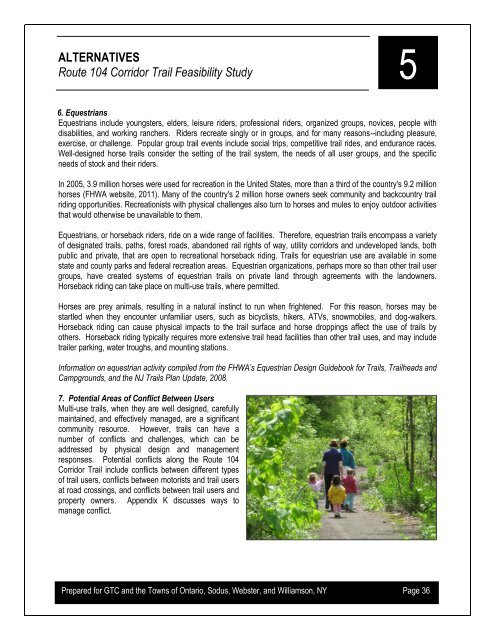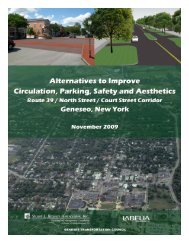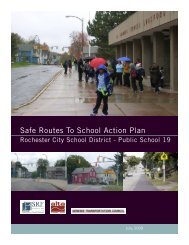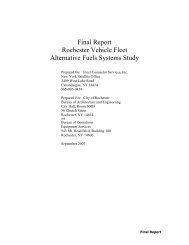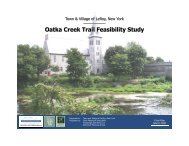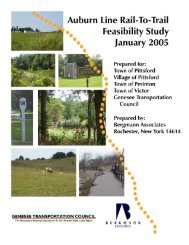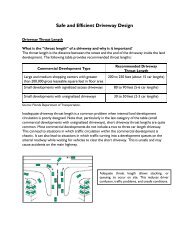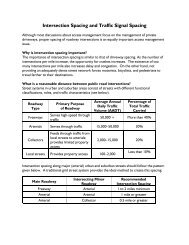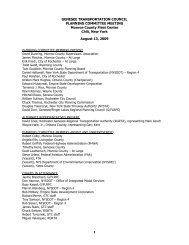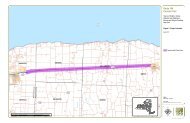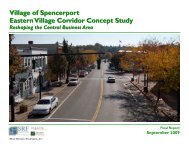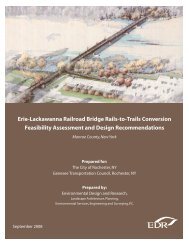Route 104 Corridor Trail Feasibility Study - Genesee Transportation ...
Route 104 Corridor Trail Feasibility Study - Genesee Transportation ...
Route 104 Corridor Trail Feasibility Study - Genesee Transportation ...
You also want an ePaper? Increase the reach of your titles
YUMPU automatically turns print PDFs into web optimized ePapers that Google loves.
ALTERNATIVES<br />
5<br />
<strong>Route</strong> <strong>104</strong> <strong>Corridor</strong> <strong>Trail</strong> <strong>Feasibility</strong> <strong>Study</strong><br />
6. Equestrians<br />
Equestrians include youngsters, elders, leisure riders, professional riders, organized groups, novices, people with<br />
disabilities, and working ranchers. Riders recreate singly or in groups, and for many reasons--including pleasure,<br />
exercise, or challenge. Popular group trail events include social trips, competitive trail rides, and endurance races.<br />
Well-designed horse trails consider the setting of the trail system, the needs of all user groups, and the specific<br />
needs of stock and their riders.<br />
In 2005, 3.9 million horses were used for recreation in the United States, more than a third of the country's 9.2 million<br />
horses (FHWA website, 2011). Many of the country's 2 million horse owners seek community and backcountry trail<br />
riding opportunities. Recreationists with physical challenges also turn to horses and mules to enjoy outdoor activities<br />
that would otherwise be unavailable to them.<br />
Equestrians, or horseback riders, ride on a wide range of facilities. Therefore, equestrian trails encompass a variety<br />
of designated trails, paths, forest roads, abandoned rail rights of way, utility corridors and undeveloped lands, both<br />
public and private, that are open to recreational horseback riding. <strong>Trail</strong>s for equestrian use are available in some<br />
state and county parks and federal recreation areas. Equestrian organizations, perhaps more so than other trail user<br />
groups, have created systems of equestrian trails on private land through agreements with the landowners.<br />
Horseback riding can take place on multi-use trails, where permitted.<br />
Horses are prey animals, resulting in a natural instinct to run when frightened. For this reason, horses may be<br />
startled when they encounter unfamiliar users, such as bicyclists, hikers, ATVs, snowmobiles, and dog-walkers.<br />
Horseback riding can cause physical impacts to the trail surface and horse droppings affect the use of trails by<br />
others. Horseback riding typically requires more extensive trail head facilities than other trail uses, and may include<br />
trailer parking, water troughs, and mounting stations.<br />
Information on equestrian activity compiled from the FHWA’s Equestrian Design Guidebook for <strong>Trail</strong>s, <strong>Trail</strong>heads and<br />
Campgrounds, and the NJ <strong>Trail</strong>s Plan Update, 2008.<br />
7. Potential Areas of Conflict Between Users<br />
Multi-use trails, when they are well designed, carefully<br />
maintained, and effectively managed, are a significant<br />
community resource. However, trails can have a<br />
number of conflicts and challenges, which can be<br />
addressed by physical design and management<br />
responses. Potential conflicts along the <strong>Route</strong> <strong>104</strong><br />
<strong>Corridor</strong> <strong>Trail</strong> include conflicts between different types<br />
of trail users, conflicts between motorists and trail users<br />
at road crossings, and conflicts between trail users and<br />
property owners. Appendix K discusses ways to<br />
manage conflict.<br />
Prepared for GTC and the Towns of Ontario, Sodus, Webster, and Williamson, NY Page 36


